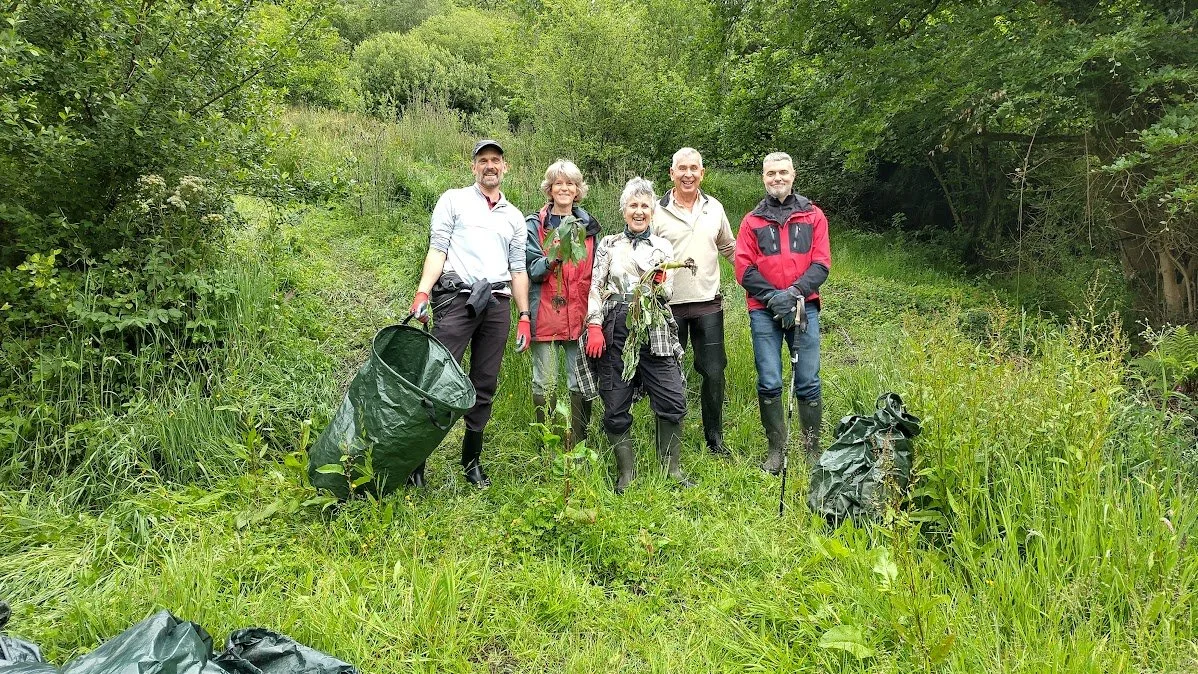The Aliens are here!
Hello again! As promised, this time I’ll be talking about Himalayan balsam – an alien species that is threatening the River Lim. And how you can join our intrepid group of volunteer ‘pullers’ tackling the problem.
Himalayan balsam is not the only alien invader that has landed in these parts. We also have Japanese knotweed that puts down seriously deep roots and outcompetes native species. The best way to eradicate it is injection of a toxic chemical into the stems of the plants themselves, but it’s best left to trained professionals, and an eradication programme is already underway on various parts of the river.
Then there’s the American signal crayfish. Ridiculously introduced as a food source in the mid-70s, they inevitably escaped and were soon thriving in our rivers, lakes and ponds, including our own River Lim. So far, so bad. But not only were they bigger than the native crayfish and able to outcompete them, they also brought with them a fungus that killed the natives – they themselves being immune. Once the aliens establish themselves in a watercourse, all the native crayfish downstream are done for. Oh, yes! And to add insult to injury, they also undermine riverbanks by tunnelling into them. As far as I’m aware, there’s very little can be done to get rid of them once they are in situ.
Meanwhile there’s the Himalayan balsam, which we can do something about. People often say, ‘But I like Himalayan balsam. It’s really pretty – and bees love it, so what’s the problem?’ Well, there are quite a few problems actually. The balsam plants grow incredibly quickly, outcompeting the native species and quickly dominating an area. On riverbanks, they blanket an area, but their incredibly shallow roots don’t give stability like native plants would. The end result leads to erosion and loss of land. As for the bees loving balsam – yes, they do – to the detriment of native species, which the bees neglect. And balsam is spreading everywhere. If you’ve ever taken a train east from Axminster in the summer months, you’ll have seen vast swathes of pink marching across the landscape.
The ‘Pullers’
That’s why I, and a dedicated team spent quite a bit of the weekend ‘on the pull’. You see, Himalayan balsam is very easy to pull up – and once uprooted, it doesn’t re-root, so it’s done for. We worked on a hillside that we had discovered last year, and while there were plenty of new plants to uproot, we could definitely see the difference we had made, with plenty of native species, such as flag irises, meadowsweet and pendulous sedge reclaiming the space. It’s an ongoing battle and even if we eliminate 90% of the balsam on the Lim catchment this year, we will still need to keep going for a good few years. There’s another hillside of balsam we need to tackle, not to mention the main river course and various lakes and fields where more plants lurk. And there’s an urgent need to take down the plants soon before those lovely pink flowers set seed. Once the seed heads are developed, the merest touch or breath of wind detonates them, firing seeds a distance of up to 3 metres to sprout the next year.
As you will have gathered, it’s a huge task we’ve taken on and we are always on the lookout for volunteers. I’m not going to pretend it isn’t hard work, but it’s also good fun. People who join us for a morning ‘on the pull’ are often surprised by how much they enjoy it.
I’ve always been amused when I hear of surveys or ‘scientific studies’ (usually paid for by a company with something related to sell) where they enthusiastically extol the virtues of something we all knew was a good thing to start with. During the lockdown days of COVID, there was a plethora of reports about how scientists have proved that being in the countryside was good for our mental health. Or that people felt happier when they heard birdsong or saw birds in the wild. When I briefly worked at the BBC Radio Science Unit as a reporter, we had a pile of these stories under the heading, ‘Science of the Bleeding Obvious’. The thing is, working in the great outdoors, doing something worthwhile with a bunch of like-minded people for a common purpose is really enjoyable - uplifting even. We all get a buzz from seeing how much balsam we have pulled and how much ground we have cleared.
We have a stalwart crew of regulars, who are brilliant and deserve massive thanks. But you don’t have to commit to joining every working party or to sticking around for a whole shift. Any time that people can spare us is gratefully received.
Just visit the Turn Lyme Green website for details for dates and locations – turnlymegreen.co.uk . Do sign up and join us. A few more sessions are scheduled. Mostly, we will be working the upper reaches of the Lim, but if it all goes well, we’ll be working our way downriver – maybe as far as into town. And if we don’t get to be on the pull in town this year, then I’m sure we will next year… Until next time, Mark




